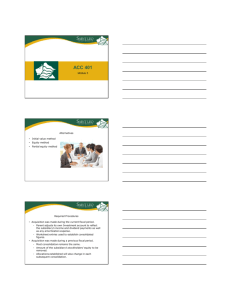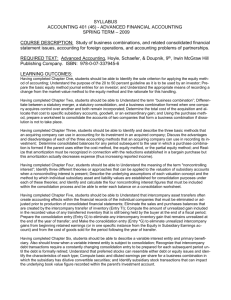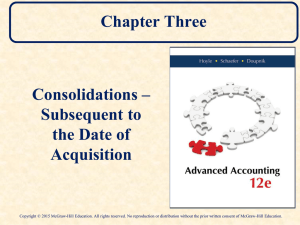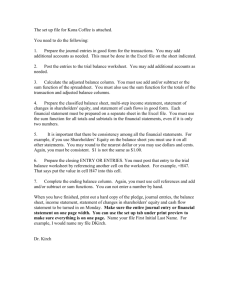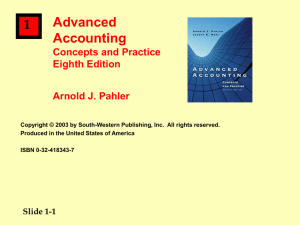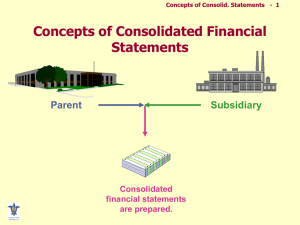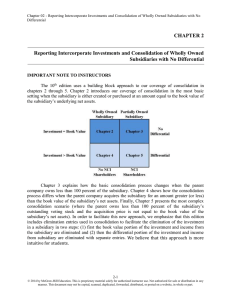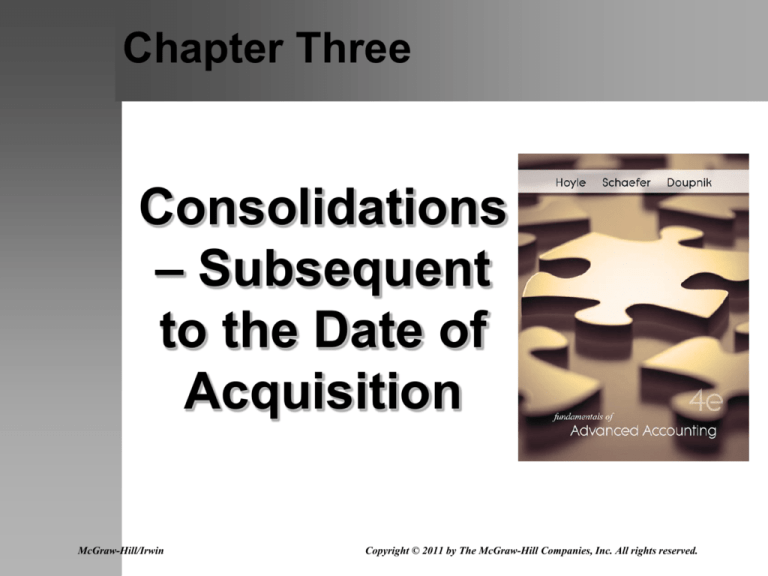
Chapter Three
Consolidations
– Subsequent
to the Date of
Acquisition
McGraw-Hill/Irwin
Copyright © 2011 by The McGraw-Hill Companies, Inc. All rights reserved.
3-2
Investment Accounting
Method
Investment Account
Income Account
Equity
Continually
adjusted to reflect
ownership of
acquired company.
Income accrued as
earned;
amortization and
other adjustments
are recognized.
Initial Value
Remains at InitiallyRecorded cost
Cash received is
recorded as
Dividend Income
Partial Equity
Adjusted only for
accrued income and
dividends received
from acquired
company.
Income accrued as
earned; no other
adjustments
recognized.
3-3
Subsequent Consolidation Equity Method
During the year, the Parent will adjust its
investment account for the Subsidiary
under application of the equity method.
The original investment, recorded at the
date of acquisition, is adjusted for:
1. FMV adjustments and other
intangible assets,
2. The parent’s share of the sub’s
income (loss), and
3. The receipt of dividends from the
sub.
Subsequent Consolidation Worksheet Entries
3-4
S)
A)
A)
I)
I)
D)
E)
E)
F)
The Sub’s equity accounts are eliminated.
Other intangible assets are recorded and
the Sub’s assets are adjusted to FV.
The Equity in Sub Income account is
eliminated.
The Sub’s dividends are eliminated.
Amortization Expense is recorded for the
FMV adjustments and other intangible
assets that were recorded in consolidation.
3-5
Subsequent Consolidation –
Equity Method – Example Entry S
Common Stock (Sun Company). . . . 200,000
APIC (Sun Company) . . . . . . . . . . . . 20,000
R/E, 1/1/10 (Sun Company) . . . . . . . 380,000
Investment in Sun Company . . . . . . . . . . 600,000
Note: If this is the first year of
the investment, and the
investment was made at a
time other than the beginning
of the fiscal year, then preacquisition income of the sub
must be accounted for in the
retained earnings balance.
3-6
Subsequent Consolidation –
Equity Method – Example Entry A
Trademarks . . . . . . . . . . . . . . .20,000
Patented technology . . . . . . .130,000
Goodwill . . . . . . . . . . . . . . . . .80,000
Equipment . . . . . . . . . . . . . . . . . . 30,000
Investment in Sun Company . . . 200,000
Note: In the first year, the FV
adjustments for this entry are
calculated in the allocation
computation. In subsequent years, the
FV adjustments must be reduced by
any depreciation taken in prior
consolidations.
3-7
Subsequent Consolidation –
Equity Method–Example Entry I&D
Equity in Subsidiary Earnings . . .93,000
Investment in Sun Company. . . . . . . 93,000
Investment in Sun Company . . . . 40,000
Dividends Paid . . . . . . . . . . . . . . . . 40,000
3-8
Subsequent Consolidation –
Equity Method – Example Entry E
Amortization Expense . . . . . . . . . 13,000
Equipment . . . . . . . . . . . . . . . . . . . 6,000
Patented Technology . . . . . . . . . . . . . . . . . . . 13,000
Depreciation Expense . . . . . . . . . . . . . . . . . . . 6,000
Remember: Never
amortize land or
goodwill!
3-9
Applying the Initial Value Method
If the Initial Value Method is used by the parent
company to account for the investment, then the
consolidation entries will change only slightly.
Remember . . . The PARENT will record the sub’s
activity differently under this method, so the Parent’s
accounts will differ from the Equity Method.
1. No adjustments are recorded in the
Investment account for current year
operations, dividends paid by the subsidiary,
or amortization of purchase price allocations.
2. Dividends received from the subsidiary are
recorded as Dividend Revenue.
3-10
Consolidation Entries –
Partial Equity Method
If the Parent uses the Partial Equity
Method, what will change from the
previous two methods?
Remember, the Parent’s record-keeping is
limited to two periodic journal entries:
1) the annual accrual of subsidiary income and
2) the receipt of dividends.
So, the Investment and Income
account balances will differ from
the other methods, and so will
worksheet Entries I and D.
3-11
Other Consolidation Entries
In addition to the Entries S, A, I, D, & E,
we will also eliminate intercompany
payables or receivables.
AND, if control acquired is
less than 100%, an
additional adjustment must
be made (see Chapter 4).
3-12
Consolidation Entries –
ALL METHODS
Now, check out the consolidated results!
No matter which method the Parent
chooses to record the Sub’s activity,
the consolidated totals end up
the SAME!
This is because we are eliminating all the
entries that we made during the year,
regardless of the method used,
and regardless of the amount!
3-13
Goodwill and Other Intangible
Assets (ASC Topic 350)
Generally, once goodwill has been recorded, the
value will remain unchanged.
We will adjust goodwill on the
consolidated balance sheet if:
1. We sell all or part of the related
subsidiary, or
2. We determine that there has been a
permanent decline in value (in which
case we record the impairment as an
extraordinary item).
3-14
Acquisition Method – Accounting
for Contingent Consideration
What if part of the consideration to be
transferred is contingent on a future
event?
Then the acquiring firm must estimate
the fair value of the contingent portion
and record a liability in consolidation.
The amount of the payment, times
The likelihood it will be paid, times,
A factor for the time value of money
(represented as [1 / (1+%)]

